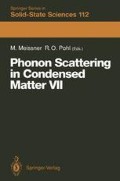Abstract
In this paper we report a new feature of the effect of nonequilibrium acoustic phonons on exciton radiative transitions. Free excitons(FEs) are usually presented with the simple model of the hydrogen atom which is actually accurate only for a model of ideal semiconductor with nondegenerate isotropic and parabolic valence and conduction bands. However all crystals with the diamond or zinc blende symmetry have a degenerate valence band at zero k-values. Some of those materials have their absolute minima of the forbidden gap with the nonzero k-values. The FE radiative decay in semiconductors with indirect gap proceeds via an intermeduate state. At low temperature the exciton electron emits a near zone edge phonon. It then annihilates a hole in the valence band, emitting a photon. Another possibility for the FE to recombine, is for the exciton hole to be scattered to a high k-value state in the valence band allowing the electron to make a vertical transition again emitting a photon. These two recombination paths interfere with each other so that the total probability of the FE radiative decay becomes dependent on the final state energy. Indeed this complicated zone structure does not allow the separation of the center of mass and relative motions. This is considered as a perturbation that lift the degeneracy of the hole state in the FE[1,2]. In the particular case of Si and Ge the FE ground state is split into two Kramers subbands due to the symmetry of this interaction[3]. The optical transitions matrix elements between split valence band states and indirect minima of the conduction band are of different values because of the interference effect which accompanied by the different amplitudes for the hole states involved in these transitions.
Access this chapter
Tax calculation will be finalised at checkout
Purchases are for personal use only
References
McLean T P, Loudon R J Phys. Chem. Solids 13, 1, (1960)
Smith D L, McGill T C Phys, Rev. B14, 2448, (1976)
Lipari N O, Altarelli M Phys. Rev. B15, 4883, (1977)
Hammond R B, Silver R N Sol. State Commun. 28, 993, (1978)
Zinov’ev N N, Kovalev D I, Yaroshetskii I D this volume.
Author information
Authors and Affiliations
Editor information
Editors and Affiliations
Rights and permissions
Copyright information
© 1993 Springer-Verlag Berlin Heidelberg
About this paper
Cite this paper
Zinov’ev, N.N., Kovalev, D.I., Yaroshetskii, I.D. (1993). Nonequilibrium Acoustic Phonon Influence on Quantum Interference of Free-Exciton Radiative Decay. In: Meissner, M., Pohl, R.O. (eds) Phonon Scattering in Condensed Matter VII. Springer Series in Solid-State Sciences, vol 112. Springer, Berlin, Heidelberg. https://doi.org/10.1007/978-3-642-84888-9_38
Download citation
DOI: https://doi.org/10.1007/978-3-642-84888-9_38
Publisher Name: Springer, Berlin, Heidelberg
Print ISBN: 978-3-642-84890-2
Online ISBN: 978-3-642-84888-9
eBook Packages: Springer Book Archive

